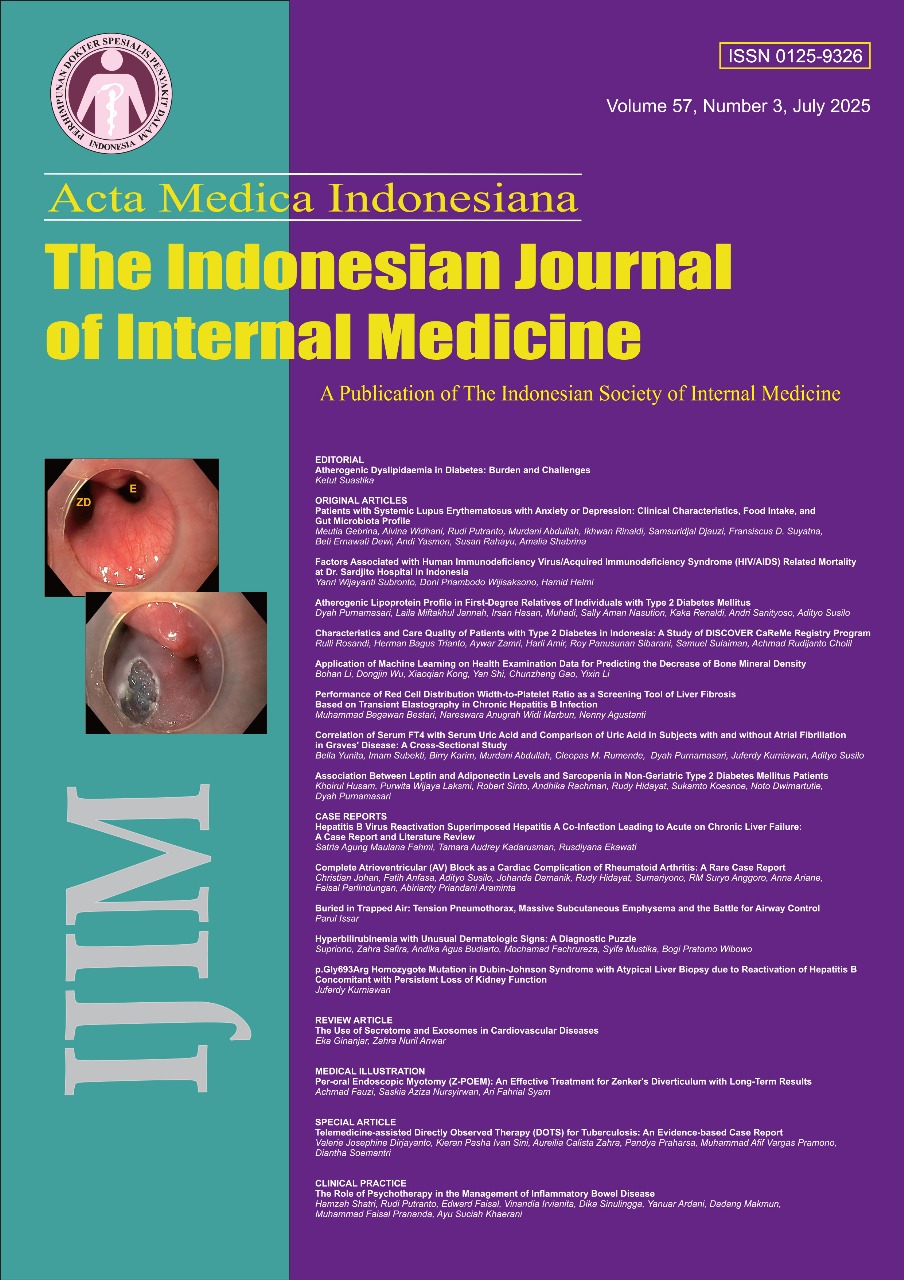Factors Associated with Human Immunodeficiency Virus/Acquired Immunodeficiency Syndrome (HIV/AIDS) Related Mortality at Dr. Sardjito Hospital in Indonesia
Keywords:
HIV, AIDS, antiretroviral therapy, mortality, death, risk factor, immunocompromisedAbstract
Background: By 2019, the human immunodeficiency virus (HIV) had infected approximately 3.8 million people in Southeast Asia and caused 120,000 deaths. In Indonesia, despite periodic fluctuations, the incidence of HIV/AIDS continues to rise annually. Although antiretroviral therapy (ART) has substantially extended the lives of people living with HIV/AIDS (PLWHA), various risk factors continue to influence treatment outcomes. This study aimed to identify the risk factors significantly associated with mortality among PLWHA undergoing ART therapy at RSUP Dr. Sardjito Hospital, Yogyakarta, Indonesia. Methods: In a retrospective cohort design, we reviewed sociodemographic and clinical data of all adult PLWHA (aged ≥18 years) who initiated ARV therapy at RSUP Dr. Sardjito Hospital between January 2008 and December 2021. Patients with incomplete baseline data or those referred from other facilities were excluded. The final cohort was categorized into surviving and deceased groups. Univariate and multivariate logistic regression analyses were conducted to determine the factors linked to mortality, and survival probabilities were estimated using Kaplan–Meier curves. Results: Out of 1,591 patients included in the study, 199 died during the follow-up period. Univariate analysis revealed that age over 45 years, tuberculosis status, low CD4+ count, occupation, and advanced clinical stage of HIV/AIDS were significantly associated with mortality. Multivariate analysis further demonstrated that low CD4+ count, employment status, and, most notably, advanced clinical stage (stages 3 and 4) were independent predictors of death. The survival probabilities at 1 and 5 years were 89% and 87%, respectively. Conclusion: Occupation, CD4+ count, and clinical stage critically influence mortality in PLWHA on ART therapy, with advanced clinical stage being the most significant. Early diagnosis and prompt ART initiation are essential to enhance survival.References
Gheibi Z, Shayan Z, Joulaei H, Fararouei M, Beheshti S. Determinants of AIDS and non-AIDS related mortality among people living with HIV in Shiraz, southern Iran: a 20-year retrospective follow-up study. 2019;1–11.
Kementrian Kesehatan Republik Indonesia. Infodatin HIV 2020. Jakarta: Pusat data dan informasi kementerian kesehatan republik Indonesia. 2020.
Kementrian Kesehatan Republik Indonesia. Laporan Perkembangan HIV AIDS & Penyakit Infeksi Menular Seksual (PIMS) Triwulan III Tahun 2020. Jakarta: Direktorat Jenderal Pengendalian Penyakit dan Penyehatan Lingkungan. 2020.
Dharan NJ, Radovich T, Che S, et al. HIV treatment regimens and adherence to national guidelines in Australia: an analysis of dispensing data from the Australian Pharmaceutical Benefits Scheme. 2019;1–11.
Putri AJ, Darwin E. Artikel penelitian pola infeksi oportunistik yang menyebabkan kematian pada penyandang AIDS di RS Dr. M. Djamil Padang tahun 2010- 2012. 2012;4(1):10–6.
Siraj M, Gedamu S, Tegegne B. Predictors of survival time among HIV-infected adults after initiating anti-retroviral therapy in Kombolcha town: A 5-year retrospective cohort study. HIV/AIDS-Research and Palliative Care. 2022:181 194.
Tuot S, Kuo A, Teo J, et al. Risk factors of HIV infection among female entertainment workers in Cambodia: Findings of a national survey. 2020;1–13.
Drain PK, Losina E, Parker G, et al. Risk factors for late-stage HIV disease presentation at initial HIV diagnosis in Durban, South Africa. 2013;8(1):1-6.
Kusumaadhi ZM, Farhanah N, Sofro MAU. Risk factors for mortality among HIV/AIDS patients. Diponegoro International Medical Journal. 2021;2(1):20–19.
Wubshet M, Berhane Y, Worku A, Kebede Y, Diro E. High loss to follow-up and early mortality create substantial reduction in patient retention at antiretroviral treatment program in North-West Ethiopia. 2012;2012.
Yemane D, Kinde S, Medhin G, Cherinet Y. Burden of metabolic syndrome among HIV-infected patients in Southern Diabetes & Metabolic Syndrome. Diabetes & Metabolic Syndrome: Clinical Research & Reviews. 2014;8(2):102–7.
Polyak CS, Yuhas K, Singa B, Khaemba M. Cotrimoxazole prophylaxis discontinuation among antiretroviral-treated HIV-1-infected adults in Kenya: A randomized non-inferiority trial. 2016; 361:1–16.
Kusumaadhi ZM, Farhanah N, Achsan M, Sofro U. Risk factors for mortality among HIV / AIDS patients. 2021;2(1):20–9.
Gesesew H, Tsehaineh B, Massa D, Tesfay A, Kahsay H, Mwanri L. The role of social determinants on tuberculosis / HIV co-infection mortality in southwest Ethiopia: a retrospective cohort study. BMC Res Notes. 2016;4–11.
Downloads
Published
How to Cite
Issue
Section
License
Copyright (c) 2025 Yanri Wijayanti Subronto, Doni Priambodo Wijisaksono, Hamid Helmi

This work is licensed under a Creative Commons Attribution 4.0 International License.
Copyright
The authors who publish in this journal agree to the following requirements:
- Authors retain copyright and grant the journal right of first publication with the work simultaneously licensed under a Creative Commons Attribution 4.0 International License (CC BY 4.0) that allows others to share the work with an acknowledgement of the work's authorship and initial publication in this journal.
- Authors can enter into separate, additional contractual arrangements for the non-exclusive distribution of the journal's published version of the work (e.g., post it to an institutional repository or publish it in a book), with an acknowledgement of its initial publication in this journal.
- Authors are permitted and encouraged to post their work online (e.g., in institutional repositories or on their website) before and during the submission process, as it can lead to productive exchanges, as well as earlier and greater citation of published work. (See The Effect of Open Access)
Privacy Statement
The names and email addresses entered in this journal site will be used exclusively for the stated purposes of this journal and will not be made available for any other purpose or to any other party.



